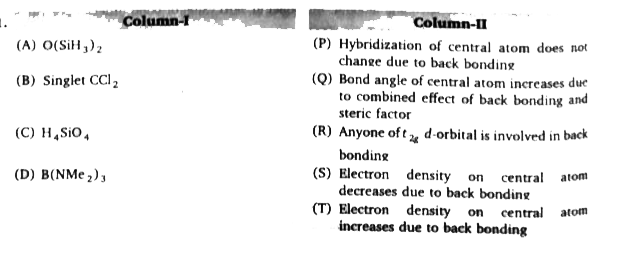The comcept of redistribution of energy in different orbitals of an atom associated with different energies to give new orbitals of equal (or somethimes it may be non-equal) energy oriented in space in definite directions is called hybridization and formed new orbitals are called hybrid orbitals. The bonds formed by such orbitals are called hybrid bonds. The process of mixing of orbitals itself requires some energy. Thus, some additional energy, is needed for the hybridisation (mixing) of atomic orbitals.
Q. Select from each set the molecule or ion having the smallest bond angle :
(i) H2Se,H2TeandPH3
(ii) NO−2andNH−2
(iii) POF3andPOCl3 (X−P−X angle)
(iv) OSF2Cl2andSF2(CH3)2 (F−S−F angle)
H2Se,NH−2POF3andOSF2Cl2
H2Te,NO−2,POF3andSF2(CH3)2
PH3,NH−2,POCl3andSF2(CH3)2
H2Te,NH−2,POF3andSF2(CH3)2
The correct Answer is:D
Order of bond angle:
(I)PH3>H2Se>H2Te (II)NO−2>NH−2 (III)POCl3>POF3(X−P−Xangle) (iv)OSF2Cl2>SF2(CH3)2(∠F−S−F)
Topper's Solved these Questions
- CHEMICAL BONDING (ADVANCED)Book:VK JAISWALChapter:CHEMICAL BONDING (ADVANCED)Exercise:ONE OR MORE ANSWER IS/ARE CORRECT
Explore 84 Videos
- CHEMICAL BONDING (ADVANCED)Book:VK JAISWALChapter:CHEMICAL BONDING (ADVANCED)Exercise:MATCH THE COLUMN
Explore 26 Videos
- CHEMICAL BONDING (ADVANCED)Book:VK JAISWALChapter:CHEMICAL BONDING (ADVANCED)Exercise:Level 2
Explore 156 Videos
- CHEMICAL BONDING (BASIC)Book:VK JAISWALChapter:CHEMICAL BONDING (BASIC)Exercise:Level 3 (Passive 11)
Explore 6 Videos
Similar Questions
Which is correct statement ?
View SolutionColumn-I and Column-II contains four entries each. Entries of Column -I are to be matched with some entries of Column-II. One or more than one entries of Column-I may have the matching with the same entries of Column-II.

View SolutionConsider the given figure showing the formation of H+2 ion depending on intermuclear distance versus potential energy of the system.

View SolutionConsider the following elements with their period number and valence electrons.
ElementsPeriod numberTotal valencee−P24Q26R37S33T36U34
According to the given informations, answer the following questions :
Choose incorrect statement :
View SolutionThe bond angle formed by different hybrid orbitals are in the order
View SolutionThe difference in energy between the molecule orbital formed and the combining atomic orbitals is called
View SolutionThe band formed atomic orbitals of lower energy is called….. While that formed from atomic orbitals of higher energy is called…..
View SolutionThe band formed atomic orbitals of lower energy is called….. While that formed from atomic orbitals of higher energy is called…..
View SolutionThe bond angle formed by different hybrid orbitals are in the order
View SolutionThe comcept of redistribution of energy in different orbitals of an atom associated with different energies to give new orbitals of equal (or somethimes it may be non-equal) energy oriented in space in definite directions is called hybridization and formed new orbitals are called hybrid orbitals. The bonds formed by such orbitals are called hybrid bonds. The process of mixing of orbitals itself requires some energy. Thus, some additional energy, is needed for the hybridisation (mixing) of atomic orbitals.
Q. Select from each set the molecule or ion having the smallest bond angle :
(i) H2Se,H2TeandPH3
(ii) NO−2andNH−2
(iii) POF3andPOCl3 (X−P−X angle)
(iv) OSF2Cl2andSF2(CH3)2 (F−S−F angle)
View SolutionThe comcept of redistribution of energy in different orbitals of an atom associated with different energies to give new orbitals of equal (or somethimes it may be non-equal) energy oriented in space in definite directions is called hybridization and formed new orbitals are called hybrid orbitals. The bonds formed by such orbitals are called hybrid bonds. The process of mixing of orbitals itself requires some energy. Thus, some additional energy, is needed for the hybridisation (mixing) of atomic orbitals.
Q. Which of the following statement is correct?
View SolutionThe comcept of redistribution of energy in different orbitals of an atom associated with different energies to give new orbitals of equal (or somethimes it may be non-equal) energy oriented in space in definite directions is called hybridization and formed new orbitals are called hybrid orbitals. The bonds formed by such orbitals are called hybrid bonds. The process of mixing of orbitals itself requires some energy. Thus, some additional energy, is needed for the hybridisation (mixing) of atomic orbitals. Q. In neutral moleule XeO_(n_(1)) F_(n_(2)) , central atom has no lone pair and ratio of (n_(2))/(n_(1)) is two, then which of the following orbitals does not participate in bonding ( n_(1) and n_(2) are natural numbers):
View SolutionSpin pairing and overlapping theory cannot explain the equal bond length as well as equal bond angles in CH_(4) molecule. To explain the above facts we are in need of hybridization theory. Hybridization is the mixing of atomic orbitals of comparable energy and the numbe of atomic orbitals involved is equal to the number of hybrid orbitals formed of equal energy. According to hybridization theory, the %s character in sp^(3) hybrid orbitals is :
View SolutionSpin pairing and overlapping theory cannot explain the equal bond length as well as equal bond angles in CH_(4) molecule. To explain the above facts we are in need of hybridization theory. Hybridization is the mixing of atomic orbitals of comparable energy and the numbe of atomic orbitals involved is equal to the number of hybrid orbitals formed of equal energy. Increasing order of the energy of hybrid orbitals is :
View SolutionHybridisation is the mixing of atomic orbital of comparable energy and the number of hybrid orbitals formed is equal to the number of pure atomic orbitals mixed up and hybrid orbitals are occupied by sigma -bond pair and lone pair. ''The hybrid orbitals are at at angle of X^(@) to one another''. This statement is not valid for which of the following hybridisation?
View Solution
